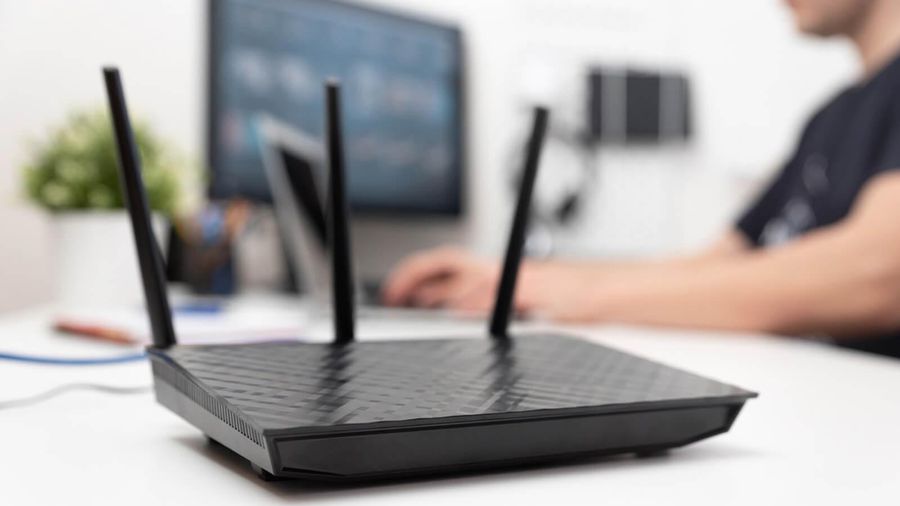What is a WiFi Karma attack?
When you're out and about, it's natural to look for WiFi networks you can connect to. After all, no one wants to use up all their available mobile data if there is an alternative. But the attraction of open WiFi networks has led to many consequences.
One of them is the WiFi Karma attack. And as you go about your daily life and your device connects to 'known networks', it's essential to be aware of the potential dangers.
Let's explore how WiFi Karma attacks work and how you can stay safe.
What is a WiFi Karma attack?
The WiFi Karma attack is a variation of the famous 'Evil Twin attack'. That's where the attacker tricks your device into connecting to a WiFi network controlled by the hacker.
Imagine a Doppelgänger trying to become your best friend to take advantage of your trust. In the tech world, this Doppelgänger is a malicious WiFi access point and the trust is the SSID (Service Set Identifier) - the name of the WiFi network.
How does the Karma attack work?

Impersonating someone you trust is an age-old trick, but in the world of technology, it's still very effective. Let's see how the Karma attack plays out.
1. Probe and listen
WiFi-capable devices have a Preferred Network List (PNL), which is like a list of trusted networks on your device. These are the networks you use all the time and save on your device to automatically connect to.
It's a time-saving feature that is unfortunately exploited.
Chances are you've saved your favorite coffee shop's WiFi network in your PNL, which might be named something like 'CoffeeBeanWiFi'. When searching for WiFi, your device keeps asking 'Is CoffeeBeanWiFi here?'.
The Karma attack begins by listening for these probe requests.
2. Mimic SSID
After listening to the poll, the attacker's device copies the requested SSID. It replied back "Hey, it's me, CoffeeBeanWiFi! Connect with me!"
3. Fraudulent links
The device unsuspectingly connects to the network and believes it has found your favorite coffee shop's WiFi connection.
This connection creates a man-in-the-middle (MitM) situation, where the attacker is now between your device and the Internet, intercepting data.
Malicious devices controlled by hackers can now eavesdrop on your WiFi connection, recording login credentials, banking details, and anything sent from your device.
Step-by-step example of a Karma attack

For example, Sarah is a frequent airport traveler and often takes advantage of working on her laptop while waiting for her flight. Here's how she can get trapped:
- Probe : Sarah's laptop signals, "Is AirportFreeWiFi here?". "AirportFreeWiFi" is the SSID of the free airport WiFi she frequently accesses. She saved the network to her device's PNL because it was too convenient.
- Impersonation : A nearby attacker captures this signal using his fake WiFi access point. The hacker's device quickly broadcast its own SSID as 'AirportFreeWiFi'.
- Falling in the trap : Sarah's laptop connects thinking it's a reliable WiFi network from an airport she's visited countless times.
- Compromise of personal data : Taking advantage of this trust, an attacker could monitor Sarah's online activities, collect data, or install malware.
What is the target of this attack?

At first glance, you might think every WiFi-enabled device with PNL is at risk. The reality is a little more complicated. As follows:
1. The device has a long PNL
Devices with a widely available Preferred Network List (PNL) are more vulnerable. This is because they have stored the names (or SSIDs) of a lot of networks they have connected to in the past. Every name on that list is an open opportunity for an impersonator attacker.
2. Old equipment, not updated
While most current smartphones and laptops have received protection patches, older devices, certain smart home devices, or those that are not updated regularly can be vulnerable to attack.
The good news is that most modern devices have security patches rolled out to protect against the Karma attack.
Modern devices with up-to-date security patches are a bit more effective at fending off attacks. They no longer shouted the names of previously connected networks but instead listened quietly.
Modern devices will only connect when they recognize a previously known, legitimate network.
3. Public WiFi
This is where risks still exist. Saved networks that don't require authentication, like most public WiFi in coffee shops and airports, remain a prime target.
This is because there is no password to confirm the authenticity of the network. Your device will most likely be eager to connect to an access point that has the same SSID as a trusted saved network. This risk exists even when the SSID is hidden.
How to protect yourself

The Karma attack is a simple trust exploit, but fortunately, the ways to protect yourself are also easy to implement:
1. Turn off auto-connect : Prevent devices from automatically connecting to WiFi networks, especially open WiFi networks. This completely eliminates the threat.
2. Cut down on PNL : Frequently forget or remove networks from your PNL. A shorter list means an attacker has fewer opportunities for exploitation.
3. Use a VPN : If you are connecting to a public WiFi network, you should use a VPN or 'Virtual Private Network'. This creates a secure encrypted path for your data. The best part is that it protects you even if you accidentally connect to a phishing network.
4. Keep your device up to date : Keep your device software up to date. This includes software and firmware updates for devices such as WiFi-connected cameras and smart home devices.
You should read it
- Difference between WiFi 5, WiFi 6 and WiFi 6E
- What is WiFi 6E? How is WiFi 6E different from WiFi 6?
- What is WiFi 6? What is WiFi 6E? Things you need to know about WiFi 6 and WiFi 6E
- 6 Wifi boosters, amplify the best Wifi wave 2020
- How to check who is using Wifi temple, your home WiFi theft
- What is Wifi? How does Wifi work?
- How to turn on WiFi on Windows 10
- How easy is Crack WiFi?
May be interested
- Can your data be stolen when using public Wifi?
 in technology terms, man-in-the-middle (mitm) is an attack that is intercepted by a third party (hackers) during communication between the server and the user. instead of the data being shared directly between the server and the user, the links will be broken by another factor. then hackers will change the content or add some malware to send to you.
in technology terms, man-in-the-middle (mitm) is an attack that is intercepted by a third party (hackers) during communication between the server and the user. instead of the data being shared directly between the server and the user, the links will be broken by another factor. then hackers will change the content or add some malware to send to you. - 6 Wifi boosters, amplify the best Wifi wave 2020
 wifi tuners, wifi extenders or wifi amplifiers are devices that receive and transmit wifi waves with the same intensity as the original device and help expand the coverage.
wifi tuners, wifi extenders or wifi amplifiers are devices that receive and transmit wifi waves with the same intensity as the original device and help expand the coverage. - How to check who is using Wifi temple, your home WiFi theft
 the network administrator will guide you how to see who is using wifi temple with wifi management software and some tips to detect if your wifi network connection is being stolen and to find ways to prevent the situation. that again.
the network administrator will guide you how to see who is using wifi temple with wifi management software and some tips to detect if your wifi network connection is being stolen and to find ways to prevent the situation. that again. - Should I turn on the WiFi router continuously or not?
 some people believe that turning on the wifi router constantly will make the device quickly fail, waste power and vulnerable to attack. however, most users say it's not really necessary to turn off the router when not in use, especially at night.
some people believe that turning on the wifi router constantly will make the device quickly fail, waste power and vulnerable to attack. however, most users say it's not really necessary to turn off the router when not in use, especially at night. - What is Wifi? How does Wifi work?
 wifi - wireless network, has now played a very important role in our daily life, work and entertainment. but to fully understand the meaning of wifi, what do we need to know?
wifi - wireless network, has now played a very important role in our daily life, work and entertainment. but to fully understand the meaning of wifi, what do we need to know? - How to hack Wifi password with Aircrack-Ng
 in this article, we will use aircrack-ng and dictionary attack method with encrypted password taken from the 4-step handshake process.
in this article, we will use aircrack-ng and dictionary attack method with encrypted password taken from the 4-step handshake process. - What is a Replay Attack?
 a replay attack occurs when a cybercriminal eavesdroves a communication over a secure network, intercepts it, then delays or resends the content, to get the recipient to do what the hacker wants.
a replay attack occurs when a cybercriminal eavesdroves a communication over a secure network, intercepts it, then delays or resends the content, to get the recipient to do what the hacker wants. - How to turn on WiFi on Windows 10
 if you are using a laptop running windows 10 and do not know how to turn on wifi, please refer to our guide below to open wifi.
if you are using a laptop running windows 10 and do not know how to turn on wifi, please refer to our guide below to open wifi. - How easy is Crack WiFi?
 no matter how much you use your computer, you know a little bit about wifi security, sometimes even more confident when using many ways to protect your wifi. but are they really effective?
no matter how much you use your computer, you know a little bit about wifi security, sometimes even more confident when using many ways to protect your wifi. but are they really effective? - What is Volumetric DDoS Attack?
 volumetric ddos attack is designed to overwhelm internal network capacity with large volumes of malicious traffic. volumetric ddos attack is usually performed against a specific target
volumetric ddos attack is designed to overwhelm internal network capacity with large volumes of malicious traffic. volumetric ddos attack is usually performed against a specific target










 MediaTek Dimensity 9300, shows impressive performance results in Geekbench 6, but still cannot beat Apple A17 Pro
MediaTek Dimensity 9300, shows impressive performance results in Geekbench 6, but still cannot beat Apple A17 Pro 8 best wireless keyboards for traveling
8 best wireless keyboards for traveling Google develops new features for Google Message
Google develops new features for Google Message How does 210W fast charging work? How does it affect battery life?
How does 210W fast charging work? How does it affect battery life? Compare useEffect, useLayoutEffect and useEffectEvent in React
Compare useEffect, useLayoutEffect and useEffectEvent in React What is ftdibus.sys on Windows? Why does it disable Memory Integrity?
What is ftdibus.sys on Windows? Why does it disable Memory Integrity?